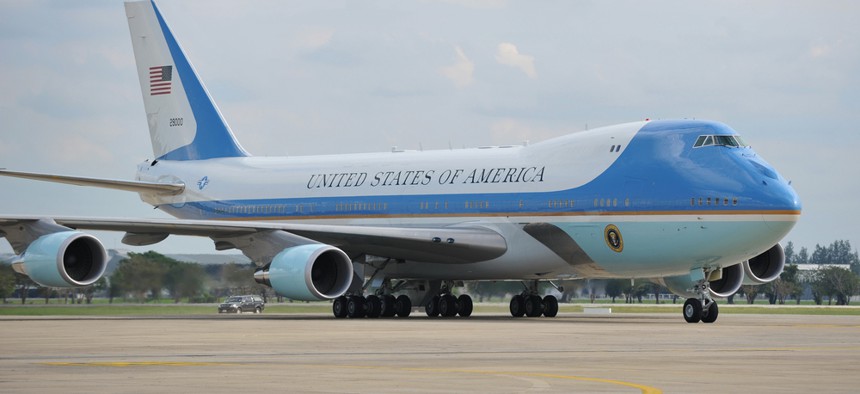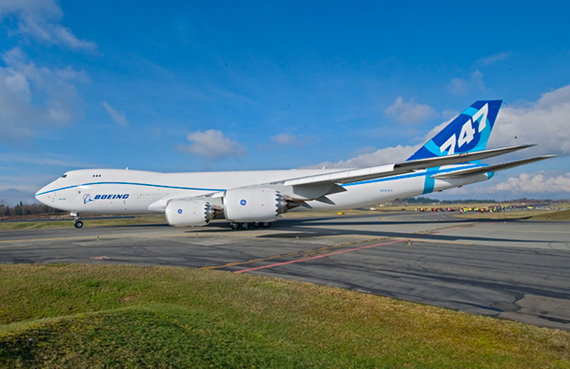
Air Force One taxis on the runway at Don Muang International Airport in 2012. 1000 Words / Shutterstock.com file photo
Air Force One-Point-Three
After a quarter-century of service, the aging presidential airplanes are being replaced by a pair of state-of-the-art Boeing 747-8s.
There's a new Air Force One on the way, and it's about time. The beat-up pair of modified 747s that have been hauling the world's most powerful passenger for 25 years are reaching the end of their useful lifespans, and are set to be replaced.
The presidential planes are renowned for the tech specs of their interior cabins, which allow a globe-trotting commander-in-chief to run the country, and even manage a war, virtually the same way he would in the White House. But their fuselages are hardly state-of-the-art.
The Air Force announced this week that it had picked the next model for its flying fortress: a Boeing 747-8 with a tail the height of a six-story building and which, according to the company's "fun facts," can carry more than $5 billion in solid gold bars from Fort Knox. (Heaven forbid the need arises...) It'll be the first complete upgrade for Air Force One since the current planes arrived in 1990 and 1991.
"I’m surprised they haven’t replaced it before now," said John Haigh Sr., a former chief steward of Air Force One who was aboard the plane that now shuttles President Obama when it first carried President George H. W. Bush in 1990. As many trivia buffs know, Air Force One is a military call number given to any aircraft carrying the sitting commander-in-chief. There are actually two identical presidential planes, and when the president takes an overnight trip, the back-up aircraft is always within a 30-minute trip away "in case there's a problem with the primary airplane," Haigh said.

Boeing 747-8/The Boeing Company
The new planes won't be ready until after Obama leaves office, and an Air Force spokesman said Friday the military expects that at least one of the two current models will still be in use in 2025, when it would carry the 46th or 47th president. That would be well past the end of its officially-projected 30-year lifespan, which only extends through 2017. With inspections before every trip, Air Force One is probably the best-maintained plane on earth, but even the military acknowledges the fleet is suffering from obsolete parts and "increased down times for maintenance" that will only get worse in the coming years.
When the new Boeing 747-8s arrive, what will happen to the current planes? The Air Force hasn't decided yet. The old pair of 707s that preceded this fleet were used for several years as a hand-me-down for non-presidential VIPs. In 2001, one of them was delivered to the Ronald Reagan Presidential Library in Simi Valley, Calif. The other plane, which carried John F. Kennedy's body back to Washington after his assassination in 1963, is on display at the National Museum of the Air Force in Ohio .
It may be newer and far more powerful, but the Boeing 747-8 isn't a radical redesign from the current planes, which themselves are customized 747-200Bs with the military designation of VC-25A. And the 747-8 has been around in some form for nearly a decade, although the latest versions debuted only in the last few years. The military won't say exactly what new technology will go into the interior other than it'll have "global, enduring, survivable command and control capability." (Sadly, there probably won't be a presidential escape pod like the one Harrison Ford used in the movie .)
Boeing boasts that it's "cleaner, quieter, and emits less greenhouse gas" than any other 747. In reality, though, the years-long hunt for a new Air Force One wasn't much of a competition. The military needs a four-engine aircraft that meets its size and weight, electrical power production, and safety requirements. After conducting market research, officials concluded the only other option was the Airbus 380, which is made in France. Due to the highly classified decisions that go into designing the presidential plane, it has to be manufactured domestically. That's not to mention the PR disaster that would follow the outsourcing of Air Force One. As Haigh put it: "We need the president's plane to be made here."
The government already endured a procurement controversy during the development of a much larger fleet of new Marine One helicopters. The Obama administration canceled its original contract after the price tag ballooned to more than $13 billion, and the cheaper choppers now won't arrive until 2020 or later. The $1.65 billion budget for the next Air Force One is expected to grow, but significant delays may be a bigger concern than a cost overrun. After 25 years of service and millions of miles in the sky, the president's current planes are old enough as it is.
(Image via 1000 Words / Shutterstock.com )






